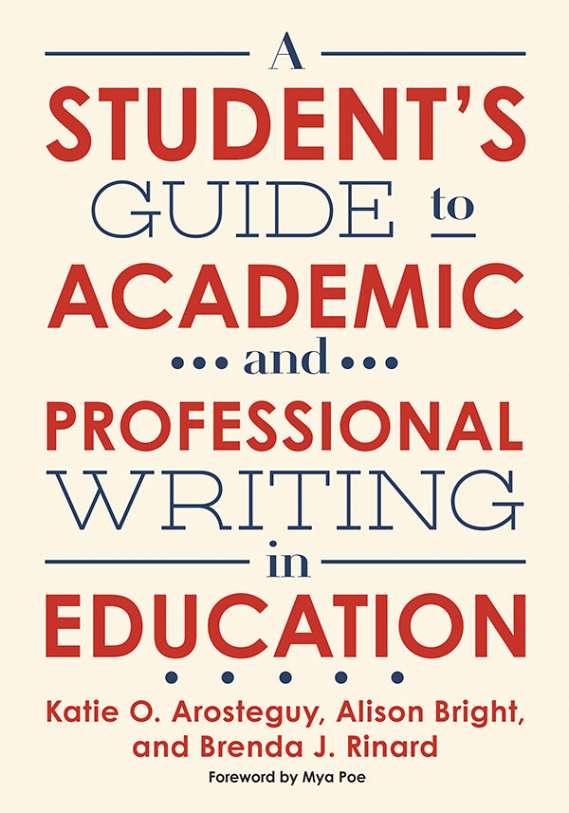Professors: Request an Exam Copy
Print copies available for US orders only. For orders outside the US, see our international distributors.
Katie O. Arosteguy, Alison Bright, Brenda J. Rinard
Foreword by: Mya Poe
Publication Date: June 7, 2019
Pages: 208

This concise handbook helps educators write for the rhetorical situations they will face as students of education, and as preservice and practicing teachers. It provides clear and helpful advice for responding to the varying contexts, audiences, and purposes that arise in four written categories in education: classroom, research, credential, and stakeholder writing. The book moves from academic to professional writing and chapters include a discussion of relevant genres, mentor texts with salient features identified, visual aids, and exercises that ask students to apply their understanding of the concepts. Readers learn about the scholarly and qualitative research processes prevalent in the field of education and are encouraged to use writing to facilitate change that improves teaching and learning conditions.
Book Features:
Katie O. Arosteguy, Alison Bright, and Brenda J. Rinard are senior lecturers in the University Writing Program at the University of California, Davis, where they teach professional writing, including a course on writing in education. They are all National Writing Project Teacher-Consultants.
"This text is accessible, student-friendly, and organized in a way that will support readers’ learning...can help teachers at any stage of their career to grow as writers. It can also help teacher-writers become the kind of teachers who reflect on their pedagogical choices and who write as a way to improve the conditions for all teachers and students."
—Teachers College Record
“Helping teacher candidates with the vast variety of writing formats and requirements is important work. The authors have done a very good job of covering almost all the bases.”
—The Texas Forum of Teacher Education
“At the heart of A Student's Guide to Academic and Professional Writing in Educationis a commitment to the value of teachers’ voices—that what teachers write matters, whether it be classroom writing, research writing, credential writing, or stakeholder writing. And it is this hopeful potential of teaching writing to aspiring teachers that underscores the value of teaching writing across the disciplines and into the community today."
—From the Foreword by Mya Poe, director of the Writing Program, Northeastern University
“My favorite thing about this book is that it acknowledges that educators write in the first place. The writing of teachers and other educators is such an important tool not only for teaching but for professional learning, for reflection, and for advocacy. This book is one tool to help prospective educators embrace all the writing that is to come.”
—Anne Elrod Whitney, Penn State College of Education
“To fulfill the promise in their title, the authors needed to be experts in writing studies, teacher education, and K–12 teaching; Arosteguy, Bright, and Rinard clearly have the necessary expertise and experience. Their guide, which is grounded in rhetorical analysis and genre study, will help student writers, not only as they become teachers but also as they teach and live in the world. Providing a mini-course in educational research, the book is useful across a number of courses and points in a credential program or on the learning-to-teach continuum. Like all the best teaching, the instruction offered emerges from work with students. The authors know the questions students might ask and the places where they might misstep. The book is supportive, analytical, logically sequenced, clear, and student friendly. Promise fulfilled.”
—Tim Dewar, Gevirtz Graduate School of Education, UC Santa Barbara
Contents
Foreword by Mya Poe
Preface
Acknowledgments
PART I: ACADEMIC WRITING
Chapter 1. The Educational Landscape: How and Why Educators Write
Writing in Education Is Rhetorical
Genres as Responses to Rhetorical Situations
The Role of Reflective Writing in Education
Types of Writing in Education: How this Guide Is Organized
Conclusion
Chapter 2. Style Issues in Writing in Education
Understanding the Hierarchy of Rhetorical Concerns
Avoiding Bias in Your Writing
Writing Concisely and Clearly
Exercises
Chapter 3. Writing the Reading Response
Examining the Rhetorical Situation: Purpose, Audience, Context, Voice, and Genre
Preparing to Write the Reading Response: Engaging Your Active Reading Skills
Writing a Reading Response: Summarizing the Reading
Writing a Reading Response: Formulating Your Response
A Sample Reading Response
Exercises
Chapter 4. Writing with Scholarly Sources: Annotated Bibliographies and Research Papers
Examining the Rhetorical Situation: Purpose, Audience, Context, Voice, and Genre
What Is Education Research?
Types of Education Research
The Scholarly Research Process
Write an Annotated Bibliography
Draft the "Issue in Education" Paper
Exercises
Chapter 5. Writing with Qualitative Data: Field Logs, Observation Write-ups, Profiles, and Case Studies
Examining the Rhetorical Situation: Purpose, Audience, Context, Voice, and Genre
Writing a Field Log
Using the Field Log to Compose the Observation Write-Up
Writing the Educator Profile
Writing a Case Study
Conducting Action Research
Exercises
PART II: PROFESSIONAL WRITING
Chapter 6. Writing Lesson Plans
Examining the Rhetorical Situation: Purpose, Audience, Context, Voice, and Genre
Knowing Your Teaching Environment in Order to Write an Effective Lesson Plan
Designing Your Lesson Plan
Exercises
Chapter 7. Writing Teaching Philosophies
Examining the Rhetorical Situation: Purpose, Audience, Context, Voice, and Genre
Before You Write Your Teaching Philosophy
Writing the Teaching Philosophy
Exercises
Chapter 8. Writing Critical Reflections
Examining the Rhetorical Situation: Purpose, Audience, Context, Voice, and Genre
Teaching Portfolio Assessments: Demonstrating Teacher Readiness
The edTPA Format
Writing Critical Reflections in Formal Annual Evaluations
Writing Critical Reflections for Professional Growth
Exercises
Chapter 9. Writing Proposals for Educational Policy Change
Examining the Rhetorical Situation: Purpose, Audience, Context, Voice, and Genre
Using Different Genres to Write for Change
How to Write a Proposal for Policy Change
Writing the Proposal
Exercises
Chapter 10. Crediting Sources in APA Style
Why to Use Sources: Building Knowledge in the Field
How Does APA Style Differ from Formatting Styles You Already Know?
Effective Methods for Integrating Sources and Supporting Arguments
APA Documentation: Crediting Sources
Conclusion
Professors: Request an Exam Copy
Print copies available for US orders only. For orders outside the US, see our international distributors.